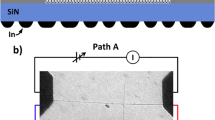Abstract
Carbon nanotubes and graphene are candidate materials for nanoscale electronic devices1,2. Both materials show weak acoustic phonon scattering and long mean free paths for low-energy charge carriers. However, high-energy carriers couple strongly to optical phonons1,3, which leads to current saturation4,5,6 and the generation of hot phonons7. A non-equilibrium phonon distribution has been invoked to explain the negative differential conductance observed in suspended metallic nanotubes8, while Raman studies have shown the electrical generation of hot G-phonons in metallic nanotubes9,10. Here, we present a complete picture of the phonon distribution in a functioning nanotube transistor including the G and the radial breathing modes, the Raman-inactive zone boundary K mode and the intermediate-frequency mode populated by anharmonic decay. The effective temperatures of the high- and intermediate-frequency phonons are considerably higher than those of acoustic phonons, indicating a phonon-decay bottleneck. Most importantly, inclusion of scattering by substrate polar phonons is needed to fully account for the observed electronic transport behaviour.
This is a preview of subscription content, access via your institution
Access options
Subscribe to this journal
Receive 12 print issues and online access
$259.00 per year
only $21.58 per issue
Buy this article
- Purchase on Springer Link
- Instant access to full article PDF
Prices may be subject to local taxes which are calculated during checkout



Similar content being viewed by others
References
Avouris, P., Chen, Z. & Perebeinos, V. Carbon-based electronics. Nature Nanotech. 2, 605–615 (2007).
Geim, A. K. & Novoselov, K. S. The rise of graphene. Nature Mater. 6, 183–191 (2007).
Avouris, P., Freitag, M. & Perebeinos, V. Carbon-nanotube photonics and optoelectronics. Nature Photon. 2, 341–350 (2008).
Yao, Z., Kane, C. L. & Dekker, C. High-field electrical transport in single-wall carbon nanotubes. Phys. Rev. Lett. 84, 2941–2944 (2000).
Javey, A. et al. High-field quasiballistic transport in short carbon nanotubes. Phys. Rev. Lett. 92, 106804 (2004).
Park, J. Y. et al. Electron–phonon scattering in metallic single-walled carbon nanotubes. Nano Lett. 4, 517–520 (2004).
Lazzeri, M., Piscanec, S., Mauri, F., Ferrari, A. C. & Robertson, J. Electron transport and hot phonons in carbon nanotubes. Phys. Rev. Lett. 95, 236802 (2005).
Pop, E. et al. Negative differential conductance and hot phonons in suspended nanotube molecular wires. Phys. Rev. Lett. 95, 155505 (2005).
Bushmaker, A. W., Deshpande, V. V., Bockrath, M. W. & Cronin, S. B. Direct observation of mode selective electron–phonon coupling in suspended carbon nanotubes. Nano Lett. 7, 3618–3622 (2007).
Oron-Carl, M. & Krupke, R. Raman spectroscopic evidence for hot-phonon generation in electrically biased carbon nanotubes. Phys. Rev. Lett. 100, 127401 (2008).
Reich, S., Thomsen, C. & Maultzsch, J., eds, Carbon Nanotubes: Basic Concepts and Physical Properties (Wiley, 2004).
Dresselhaus, M. S., Dresselhaus, G., Saito, R. & Jorio, A. Raman spectroscopy of carbon nanotubes. Phys. Rep. 409, 47–99 (2005).
Jorio, A., Dresselhaus, M. S. & Dresselhaus, G., eds, Carbon Nanotubes: Advanced Topics in Synthesis, Structure, Properties and Applications (Springer, 2008).
Jorio, A. et al. Structural (n, m) determination of isolated single-wall carbon nanotubes by resonant Raman scattering. Phys. Rev. Lett. 86, 1118–1121 (2001).
Jorio, A. et al. Joint density of electronic states for one isolated single-wall carbon nanotube studied by resonant Raman scattering. Phys. Rev. B 63, 245416 (2001).
Fantini, C. et al. Optical transition energies for carbon nanotubes from resonant Raman spectroscopy: Environment and temperature effects. Phys. Rev. Lett. 93, 147406 (2004).
Perebeinos, V., Tersoff, J. & Avouris, P. Effect of exciton–phonon coupling in the calculated optical absorption of carbon nanotubes. Phys. Rev. Lett. 94, 27402 (2005).
Hertel, T., Perebeinos, V., Crochet, J., Arnold, K., Kappes, M. & Avouris, Ph. Intersubband decay of 1-d exciton resonances in carbon nanotubes. Nano Lett. 8, 87–91 (2008).
Bonini, N., Lazzeri, M., Marzari, N. & Mauri, F. Phonon anharmonicities in graphite and graphene. Phys. Rev. Lett. 99, 176802 (2007).
Compaan, A. & Trodahl, H. J. Resonance Raman scattering in Si at elevated temperatures. Phys. Rev. B 29, 793–801 (1984).
Capaz, R. B., Spataru, C. D., Tangney, P., Cohen, M. L. & Louie, S. G. Temperature dependence of the band gap of semiconducting carbon nanotubes. Phys. Rev. Lett. 94, 036801 (2005).
Cronin, S. B. et al. Temperature dependence of the optical transition energies of carbon nanotubes: The role of electron–phonon coupling and thermal expansion. Phys. Rev. Lett. 96, 127403 (2006).
Perebeinos, V., Tersoff, J. & Avouris, P. Scaling of excitons in carbon nanotubes. Phys. Rev. Lett. 92, 257402 (2004).
Zhang, Y., Xie, L., Zhang, J., Wu, Z. & Liu, Z. Temperature coefficients of Raman frequency of individual single-walled carbon nanotubes. J. Phys. Chem. C 111, 14031–14034 (2007).
Pop, E., Mann, D. A., Goodson, K. E. & Dai, H. Electrical and thermal transport in metallic single-wall carbon nanotubes on insulating substrates. J. Appl. Phys. 101, 093710 (2007).
Wang, S. Q. & Mahan, G. D. Electron scattering from surface excitations. Phys. Rev. B 6, 4517–4524 (1972).
Perebeinos, V., Tersoff, J. & Avouris, P. Electron–phonon interaction and transport in semiconducting carbon nanotubes. Phys. Rev. Lett. 94, 086802 (2005).
Fischetti, M. V., Neumayer, D. A. & Cartier, E. A. Effective electron mobility in Si inversion layers in metal-oxide–semiconductor systems with a high-kappa insulator: The role of remote phonon scattering. J. Appl. Phys. 90, 4587–4608 (2001).
Petrov, A. G. & Rotkin, S. V. Energy relaxation of hot carriers in single-wall carbon nanotubes by surface optical phonons of the substrate. JETP Lett. 84, 156–160 (2006).
Author information
Authors and Affiliations
Corresponding author
Supplementary information
Supplementary Information
Supplementary Information (PDF 6591 kb)
Rights and permissions
About this article
Cite this article
Steiner, M., Freitag, M., Perebeinos, V. et al. Phonon populations and electrical power dissipation in carbon nanotube transistors. Nature Nanotech 4, 320–324 (2009). https://doi.org/10.1038/nnano.2009.22
Received:
Accepted:
Published:
Issue Date:
DOI: https://doi.org/10.1038/nnano.2009.22
This article is cited by
-
Reshaping the phonon energy landscape of nanocrystals inside a terahertz plasmonic nanocavity
Nature Communications (2018)
-
Phonon bottleneck effects in rectangular graphene quantum dots
Journal of Computational Electronics (2012)
-
Thermal infrared emission from biased graphene
Nature Nanotechnology (2010)
-
Energy dissipation and transport in nanoscale devices
Nano Research (2010)



